5 Reasons to Visit the Eastern Sierra
Posted by Charlotte Dohrn on 6th Apr 2021
The mountain range known as the Sierra Nevada forms the rugged backbone of California, bisecting the populous coastal plains of the west and the state’s remote interior. Part of the American Cordillera that stretches almost uninterrupted from Alaska to the Tierra del Fuego, the Sierra boast some of California’s most striking—and most rugged—landscapes.
While the western slopes of the range are easily accessed from the Bay Area and other coastal cities, solitude and the barren beauty of the desert are your reward when you reach the eastern side. Meadows of sage and rabbitbrush blanketing the floor of the Owens Valley, abruptly giving way to rock at the foot of the towering granite escarpment. As you go further east towards Nevada’s White Mountains, the Valley transitions into a moonscape of sun scorched rock.
Distance and limited access over high mountain passes thin the crowds, making the Eastern Sierra a favorite playground for adventure seekers from Northern and Southern California (and beyond). With premier hiking, skiing, climbing, camping—and natural hot springs where you can soak sore muscles—the Eastern Sierra are worth a trip. Here is a guide to some of the highlights of California’s other side.
1. Hike the Tallest Mountain in the Lower 48
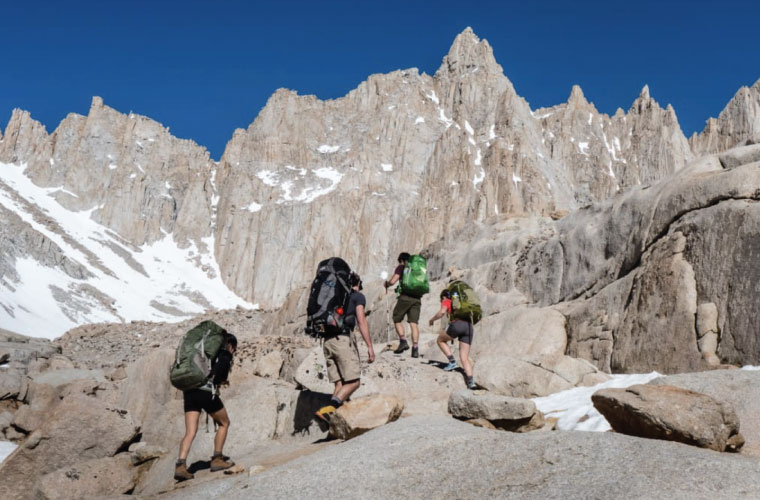
Entering the Mt. Whitney Zone en route to the summit. Pierce Martin
At 14,505 feet, Mount Whitney has earned the title of "tallest mountain" in the lower 48. The peak straddles Inyo and Tulare Counties and forms part of the Sierra Crest and the Great Basin Divide. The Mount Whitney Trail—the most popular approach—starts from Whitney Portal on the mountain’s eastern slope and climbs 6,100 feet over 11 miles to the summit. Hardy (and permitted) hikers can make the climb in a day, though if you are looking for a more humane approach and a chance to linger over the scenery, you can camp on the granite slopes to make it a two-day ascent. Whitney can be a bit of a thoroughfare on summer weekends, but there are plenty of other trails, peaks, and lakes in that promise a quieter hiking experience if that’s what you’re looking for.
2. Ski California’s Highest Slopes
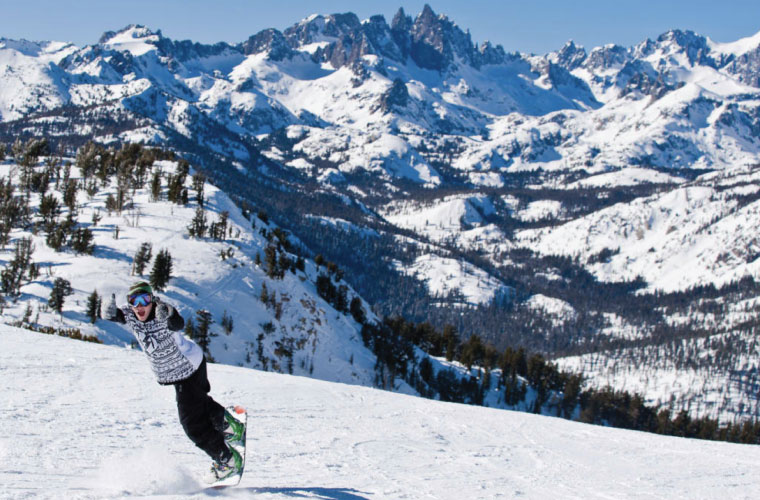
Skiers and snowboarders regularly drive up from SoCal to hit the slopes at Mammoth for a weekend. John Lemieux
The aptly named Mammoth Mountain reaches 11,053 feet at its summit, boasting over 3,000 vertical feet sprawling over 3,500 acres of skiable terrain. Known for expansive bowls, tree skiing, and fast groomers, Mammoth has something for skiers and snowboarders of all levels. In addition to some of California’s best terrain, you’ll be sure to find powder stashes after snowstorms—despite the dry climate of the Eastern Sierra, the mountain averages over 400 inches of snow per year due to its unique position in a low point of the range. Though seasonal closures of several mountain passes can make it a bit of a trek from the Bay Area during the winter, a trip to Mammoth for a taste of big mountain skiing is well worth the drive.
3. Climb the State’s Best Bouldering
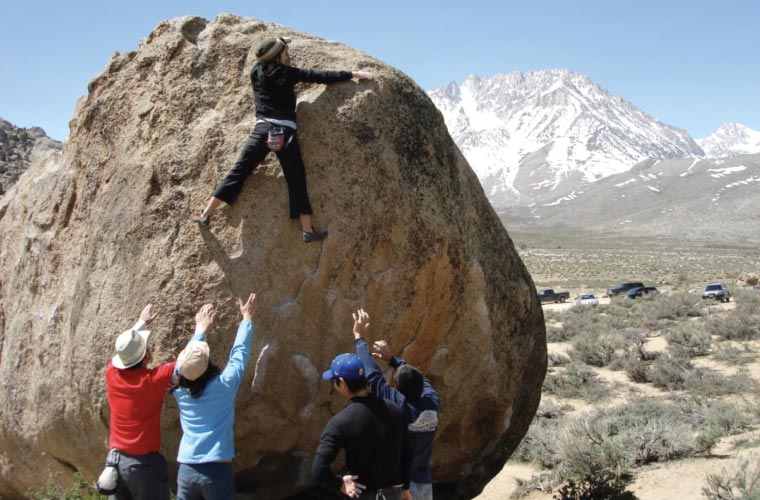
People from around the United States (and the world) travel to Bishop to climb at the Buttermilks. Mark Doliner
Second only to Yosemite in notoriety amongst climbers, the Eastern Sierra is a renowned California climbing destination. Bishop, an outpost along Highway 395, is something of a climbing mecca, drawing climbers from around the state to test themselves on world class bouldering routes. From Bishop, you’ll have access to local favorites including the Buttermilks, the Druid Stones, and the Happies and the Sads at the Volcanic Tablelands.
4. Camp… Almost Anywhere
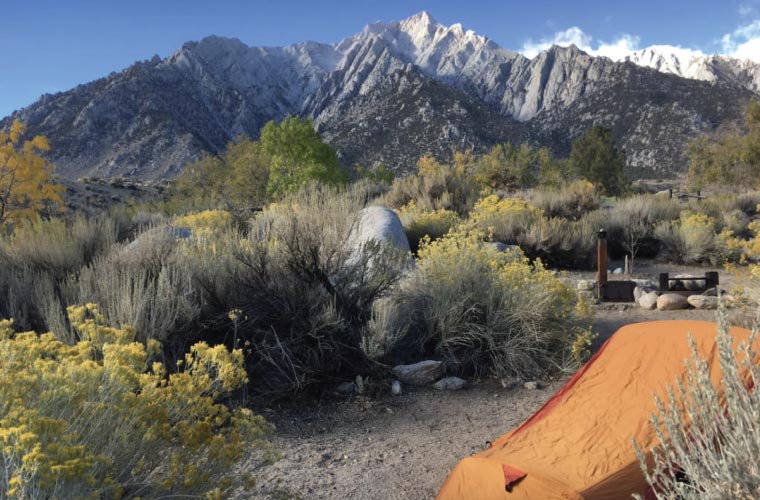
Who wouldn’t want to wake up to those views? Charlotte Dohrn
If you are used to the overwhelming process of finding camping on the west side of the mountains and along the coast, the availability of campsites throughout the Eastern Sierra will come as a relief. BLM manages large swathes of land in the region that allow free dispersed camping, as well as a number of first-come, first-served established camping areas. If you are looking for a site with more amenities, the Forest Service also maintains campgrounds throughout the area, including sites on the road from Lone Pine to Mt. Whitney, and another overlooking Silver Lake in the June Lake area near the Ansel Adams Wilderness. No matter where you camp in the Eastern Sierra, you will have expansive views of the night sky dotted with bright stars. ** **
5. Soak in Natural Hot Springs
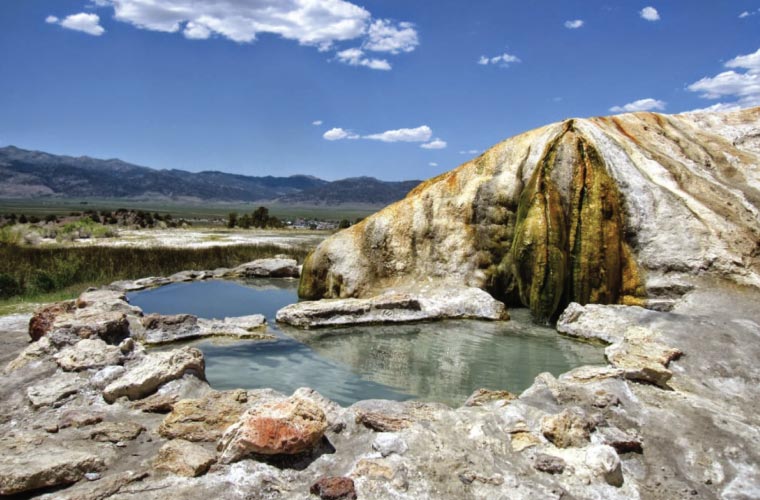
Plan time for a trip to the hot springs after a long day–you won’t regret it, and your body will thank you for it.
Part of an ancient caldera, hot springs and other volcanic relics dot the Eastern Sierra. Few experiences can match that of soaking tired muscles in hot mineral water after a long day of hiking or climbing, so be sure you make some time for a soak before the next day’s adventure. Locals and frequent visitors have their favorite hidden spots, but there are plenty of accessible pools near Bridgeport and Mammoth Lakes. If you head east on Highway 120, you’ll find the ghost town of Benton Hot Springs, which has a small inn and rustic campsites with private tubs overlooking the White Mountains.
Getting There
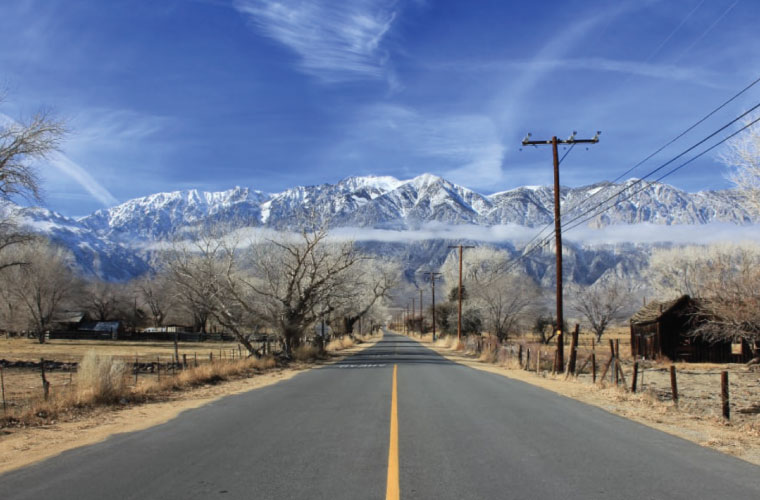
Many of the roads in the Eastern Sierra are also great for cycling.
It’s not easy to get to the Eastern Sierra from the western half of the state—which is part of its appeal. In the winter, Highway 120 over Tioga Pass is closed, blocking the most direct route from the Bay Area and necessitating a northern or southern approach. Once you’ve made it to the east side of the range, Highway 395 will serve as your go-to thoroughfare for travelling north and south. Though your best adventures will be out of the car, driving Highway 395 is an experience in and of itself. While Highway 1 along the coast and mountain roads like Highway 120 tend to get all the press, the 395 is a hidden gem of vast desert expanses flanked by towering peaks.
Written by Charlotte Dohrn for RootsRated and legally licensed through the Matcha publisher network. Please direct all licensing questions to legal@getmatcha.com.
Share on:

